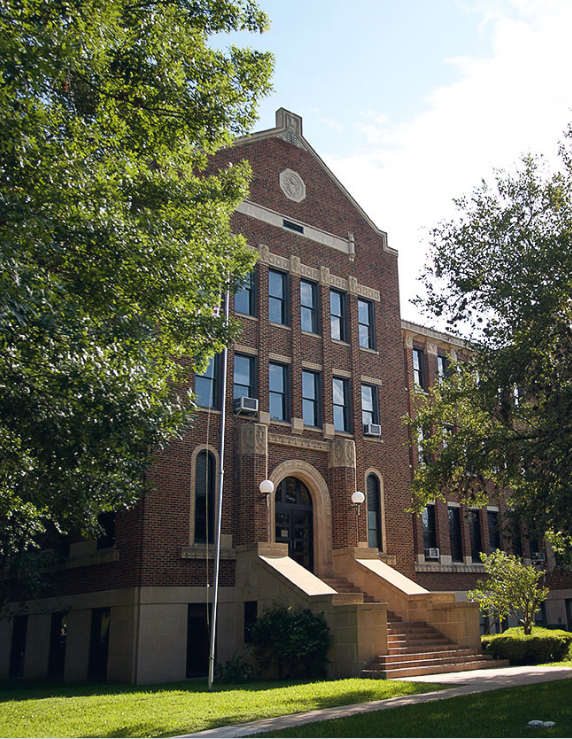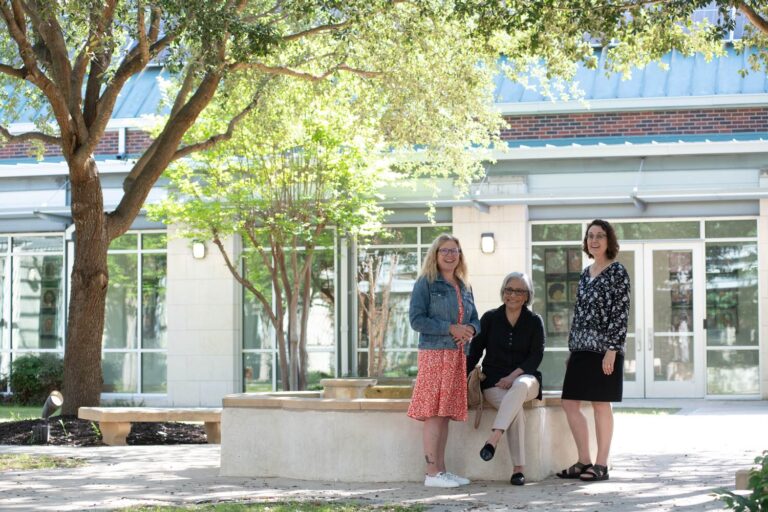Kenneth Hannon, OMI
It is such a happy honor to inaugurate this professorship and lecture series. Let me begin, please, with gratitude. I want to thank the Vance family for the gift which establishes the Louis G. Vance Chair. For years to come your generosity will bear fruit in our mission. But you have established this Chair at Oblate School of Theology – not just any academic institution – and so you know that by mission we place our academic work at the service of the Church. So our work has a self-conscious and intentional pastoral orientation. I want here to express my gratitude for the history which has shaped OST into that kind of institution – a history which urges us to continue to serve as selflessly as we can this portion of the Lord’s mission. What began as a Provincial Seminary for the Oblates came in time to collaborate with the Diocesan seminary, Assumption, and then began admitting lay people of various faith communities. OST has become a site for education and formation of a broad range of ministers to serve the Church. Finally, I would like to thank the Missionary Oblates of Mary Immaculate for having established this community of learning and formation, and for having supported it through its many iterations to the present day. I cannot help but remember with a certain poignance that nearly fifty years ago, when I inquired about entering, the Oblates assured me that I would never have to teach unless I really wanted to! God bless this wildly diverse, heartily dedicated, holy communion of sinners!
Introduction
You will have noticed that the title of the Professorship we inaugurate tonight mentions Systematic Theology. The great Canadian Jesuit theologian Bernard Lonergan says that Systematics is concerned with promoting an understanding of the realities affirmed as “doctrines.” So systematics is not so much concerned with the truth of a doctrine – questions about the existence of God the Son, for example – but rather how a divine generation can be conceived. The work of the Systematic theologian can be described as an ongoing program of exercises in understanding. Of course, this immediately implies the fundamentally dialogic nature of the effort: one seeks a valid and coherent conceptual framework for doctrine as a service to the faith of the Church itself, and of its members.[1]
My objective in this presentation is part academic and part pastoral. I hope to share with you something of the shape of the serious study of the sacramental dimension of the life of the Church and its members. I also hope – and this is the pastoral part – to invite you all into this effort at explaining, understanding and appropriating our shared tradition.
We will concern ourselves in turn with the notion of Story and then Symbol and then the Reign of God.
Story
We are a traditioning people; we always have been. The more we reflect on that process as it has taken place among us, the more evident the richness of the processes involved becomes. I mean to turn our attention first to the “Great Story” in which we live and which is canonized in the Sacred Scriptures. Here we find the privileged exposition of God’s acts in history on behalf of his chosen ones. Here we find the greatest of those saving acts, Jesus, enshrined in gospels and writings of various sorts which proclaim and meditate the Paschal Mystery of Jesus as divine self-manifestation and self-gift. Here we find the ultimate referent of our self-understanding and the indispensable interpretive base for our sacramental activity. Here we have a first word in the definition of sacrament: a memorial of the Christ-event: the person and the sayings and the doings of Jesus becoming the Christ for the world. The Scriptures are a genuine place of encounter with the Lord in his context as a Jew and heir to the long history of God’s election and fidelity. To meet him we need tools for entering this very complex literature with the respect it deserves.
If Sacramental Theology is to be rooted in the scriptures, its practitioners must take advantage of the many methodologies which are offered by the ever-evolving discipline of biblical scholarship. Some of us thought that the historical-critical method was a convenient stopping place, only to be met by a whole range of new and emerging forms of analysis. This very fact helps us to remember that our Scriptures are not a longitudinal narrative. The amazing diversity of oral and literary forms, the many-layered cultural worlds, the varied religious and cosmological languages of the ever-developing consciousness of a people not our own: these require very disciplined attention. The sheer richness of this canonical heritage, far from mere complication, accounts for the constant challenge, consolation, confusion, instruction, contradiction, entertainment and sheer joy to be found in the encounter. As we all know, each such encounter opens before us the way of conversion, which in turn, is the inner dynamic of discipleship itself.
But the Scriptures do not constitute our whole story. We are part of a millennia-old handing-on process which has its own history, or histories. For sacramental theology the history of our ways of prayer and worship is a critical part of our reception and transmission of the tradition. Clearly, the gospel is the grammar of our sacramental life, but the world itself is the vocabulary, and the grasp of things has necessarily varied as to presupposition (what we think God is up to doing) and response (how we pronounce the worthy “Amen” to what God is doing). The proclamation of the saving word leads the community to font and table, to bedside with unction, from cradle to grave with words and gestures in an effort Spirit-led, we believe, to uncover the mysteries of life and journey and nourishment and healing beneath the Providence of God. These, too have their varied histories. It is a great gift of our time that we have inherited tools to enter the histories more accurately and richly than our forebears.
This privileged access to text and custom has allowed us to appreciate that none of our sacramental rites can be said to have come by a univocal path to our day. Not in intention, not in expression. The abundance of information, provided in a manageable way for peer and non-specialist alike have helped us to become accustomed to a more nuanced appreciation of our development. Watching the trajectories of processes of initiation, for example, has shown that, as a community, we have never had a completely universal practice, nor a single interpretation or discipline. Instead, what we witness is the breathtakingly creative spirit of the church meeting different cultures, different socio-economic and political conditions and seeking to find ways to make faith in Christ vibrantly livable. Of course, even superficial study shows how many tangents, some curious, others actually pernicious, have been part of this history. This grand, complex, sometimes sad, sometimes hilarious story puts the lie in capital letters to the claim that cultural adaptation is a newfangled whim invented by silly liturgists in the seventies! On the contrary, the mandated reform of the Second Vatican Council included the observation that there would inevitably be “accretions” in our sacramental customary which required excision in order to let the core faith statement shine forth more clearly and then be re-expressed in accessible form.
Why so upbeat? you might ask in the face of such complication. Not just upbeat, I suggest, but joyfully grateful. Think just for a moment of a previous generation of theologians and believers. If we consider just the chilling effect of the “modernist crisis” of the early twentieth century, we have more than enough reason to be glad. But, in a way, it was precisely that crisis – very serious in its core, to be sure, but illegitimately applied to many an innocent theologian or pastor – which provided us with a great deal of the richness which has made us so much more able to do our work. Many might-have-been-systematicians instead turned their efforts to biblical archaeology, study of ancient languages, rendering of manuscripts and records which had been lost or inaccessible. Others studied the Fathers of the Church and their amazingly creative and varied churches. In relative peace, these Trojans provided future generations with riches they themselves could not have employed. This in turn funded the readiness of scholars to undertake critical biblical study when it was finally permitted.
The other beneficiary was what became the Liturgical Movement, which grew directly and indirectly from the new acquaintance with the preaching, teaching, worship, and controversy of the undivided Church. We may not wish to employ every text we have discovered, but at least, we know it’s there to learn from. An example might be the recognition that Eucharistic Prayer texts from before the year 200 often lacked the words of the Lord spoken over bread and cup.[2] All of our present prayers contain that narrative, but it tempers our claims about the “words” when we remember that communities of faith were able to celebrate quite fully without explicitly invoking them.
To conclude this section: Sacramental Theology begins in the careful study of our biblical roots. Far from the proof-texting of an “institution narrative” of former days, contemporary systematic studies recognize the need to respect the pluriformity of the faith in Christ and its expression in the New Testament. Modern Scripture scholarship helps Christians to be enriched by the study of the scriptures of the Hebrew Bible precisely by respecting them as the faith expressions which they are without attempting to reduce them to typologies of Christ and Church.
A similar discipline is required in order to understand our historical sacramental traditions. Our interpretations of what we discover must be contextual as to time and culture and polity and theology. The work of interpretation must also be perspectival: the interpreter, to be fair and successful, attends to the presuppositions, explicit and implicit which are imbedded in the witnesses. Inevitably one finds both the searing search to the very heart of the matter as well as the idiosyncratic distraction. By fairly attending to all of these, one can try to decipher a “deep center” of continuous witness which enables a critical reception of the witness.[3]
Symbol
The second arena of Sacramental Theology which we will explore can be designated broadly under the title Symbol. This fairly modern technical term actually refers to a specific dimension of what the ancients called “signs,” “types,” figures,” and by a number of other reasonably synonymous terms. This idea of “signification” has always been an important part of the sacramental vocabulary even as precise definitions have changed and been nuanced over time. For example, the common mentality in the ancient world would have presumed a close, even participatory relationship with the reality represented. So the signet-seal on a document announced the authenticity of the document as presented, but also, in a mysterious but palpable way, made the sender “present.” The sphragis (or seal) emblazoned upon a soldier’s forehead functioned as a warrant of his belonging to his general, for good (if he were discovered injured by his own army) or ill (should he be discovered behind enemy lines, condemning him as a traitor). On the other hand, Ambrose of Milan referred to the Eucharistic elements as “figure” of the body and blood of the Lord, admitting both a kind of participation and a distinction at the same time. Many of the early Fathers employed both/either a more “symbolic” or representational expression alongside a more “realist” expression. Thus Cyril of Jerusalem could explain that Christ’s body was bestowed upon the believer in the form of bread while his blood was given in the form of wine.[4] In another place, though, the same Father would admonish,
Do not, then, regard the bread and wine as nothing but bread and wine, for they are the body and blood of Christ as the Master himself has proclaimed.[5]
Another helpful distinction was introduced by Saint Augustine. He spoke of the difference between “natural” signs and conventional signs. Natural signs are, as the name implies, universal and empirical: e.g., smoke signals combustion – of some kind, somewhere, of something, but combustion. Conventional signs are the result of a kind of social agreement rather than a direct relation to the intended “message”; e.g., there is no relation between the color “red” and the action “stop.” But there is a very widespread convention that a red sign or a red semaphore means “Stop,” and the convention is enforced. For Augustine, sacramental symbolism is a matter of complex, conventional symbolism where the convention is born in the Scriptural witness to the sayings and doings of the Lord joined to the material element which renders the divine will concretely accessible.[6] I read somewhere that this amazingly nimble intellect was able to identify some 354 “sacraments” before he was through.
This satisfactory vagueness could not hold. Questions and controversies arose in the course of intervening centuries. There are many ways to approach these debates; but for our purposes, perhaps it is sufficient to say that they generally arose in response to a desire for a more “realist” assurance that the promise of grace or communion offered in the sacramental symbol would be kept and that it could be relied upon always to do so. This led to a wide variety of attempts to rationalize the relation between the sacramental-symbolic action and its promised effect. The classic explanation offered by St. Thomas Aquinas proposed “efficient instrumental causality,” a very subtle way of establishing the link in the faith-action of sacrament between God, Christ, Church, minister, and believer.[7] Throughout the scholastic period theologians continued to debate this matter of causality, offering various proposals, none of which was solemnly taught by the magisterium.
The concern to explain causality became a kind of obsession in both Catholic and Reform communities. In the context of the Counter-Reformation and throughout the period of manual theology the debates were very intense, positions very hardened, and often oversimplified to the point of misleading caricature.
The “return to the sources” of early teaching and reflection, especially between the wars, helped to “educate” the question once again so that the Second Vatican Council could define the liturgy of the Church as involving
…the presentation of human sanctification under the guise of signs perceptible by the senses and its accomplishment in ways appropriate to each of those signs.[8]
The Council could go on to teach that
[As signs,] they not only presuppose faith, but by words and objects they nourish, strengthen and express it…. It is, therefore of the greatest importance that the faithful should easily understand the sacramental signs.…[9]
This leads us to an insight retrieved from the Patristic Church which has greatly helped contemporary sacramental theology adopt a more holistic approach. For one thing, as the Fathers always indicated, while it is possible to think of sacrament in the abstract (as in the long causality debates), people encounter the sacraments in their enfleshed, ritualized, enacted form, that is, as events which bring together faith, meditation, proclamation of word and bodily engagement with God in the community of the church. The believing community enacts its memory of the saving Lord in sign and gesture which becomes doxology.
The reforms of the liturgy mandated by the Council turn on this recognition and on the insistence by the Council on the priority of full, conscious participation by all in the event as the “goal to be sought above all others.” This, in turn, led to the recognition of the need for the cultural articulation of the sacramental encounter precisely to render the event accessible to concrete persons in concrete communities.
Here we can introduce another critical contribution retrieved from our ancient past and given important new connotations. Many of us were trained using the Baltimore Catechism, which introduced us to the notion of sacrament as “visible sign of invisible grace.” The next question enumerated the Church’s seven official sacraments. It is the Church’s solemn teaching that there are seven sacraments of the New Law. But that pronouncement itself has an important context, namely that it is Jesus, in his humanity who is the primordial sacrament. He reveals in his fleshly existence the redeemed and redeeming relationship with creation which was willed forever by God. Whatever other sign perceptible to the senses might reveal saving grace, it flows from and toward the life and revelation of the one who pitched his tent among us. But coming to know Jesus is made possible by a second, derivative sacrament, his Church. It was his will that all nations should come to know him through the mediation of his followers. Sacramental theology today begins from that starting point of Jesus as the primordial sacrament of the encounter with God and the Church as the basic sacrament of the encounter with Jesus the Christ.
Over time, communities coalesced their memorial worship into clusters of interrelated signs and gestures to become rituals (or rites, if you like). In our time we have the advantage of ritual studies from anthropology and the social sciences to assist in “reading” rituals from our past and in determining how to shape them in our own communities. Rituals, once established, are typically very resistant to change, and for good reason: they seek to guide us into life’s deep mysteries by giving us words to speak and gestures to enact when we would otherwise perhaps be mute and frozen. On the other hand, there are times when adjustment is needed just as it is always injurious to treat something as delicate as ritual with obsessive fastidiousness over less-important details. (Of course, we’ve all seen both extremes: no doubt everyone here knows how to avoid those pitfalls!)
I have two examples to share which shed some light on aspects of sacramental ritual. One comes from an experience of liturgy while I was a graduate student at the University of Notre Dame. I was present at the priestly ordination of several young Holy Cross priests along with a good number of concelebrants. By happy accident I was seated next to a revered senior emeritus professor with whom I had become friends. As the young deacon was preparing the altar (at that time we used decanters for the wine until the fraction rite). He placed everything carefully on the altar and then prepared the chalice for the Bishop and finished by adding a dollop of water to each of the flagons. My friend, in a whisper which could be heard throughout the group of concelebrants, asked me, “What’s he doing?” Trying to quiet the situation, I simply remarked he was pouring the water. My friend answered, “I know. He’s putting it in everything. Doesn’t he know it’s a ritual, not a recipe?” Unaware, apparently of the origins of the gesture of mixing water with the wine, and the various levels of interpretation embedded there, he took it as his responsibility to assure that water was added to each and every vessel, literalizing the sign rather than allowing a single mixing to speak on its own.
A second example can demonstrate how even a minor adjustment can stand out to our attention and invite reflection and questions (sometimes for good, sometimes, not so much). Consider what the impact would be if the Sign of Peace were to be moved from its present place just before communion to the end of the Liturgy of the Word (where it was found for several early centuries at least). Not only the gesture itself, but the surrounding liturgical elements would undergo some degree of modification and reorientation.
The Reign of God
Now we turn to the last heading: The Reign of God. It is recorded of the earliest Christians that they often ended their Eucharist with the acclamation-prayer, Maranatha, “Come, Lord.”[10] They undoubtedly expected the Lord’s coming quite soon, but the aspiration has remained with us, as has the acclamation, over these many centuries. For whenever we gather in his name it is in the hope of the final fulfillment, the realization in all of the Reign of God. This eschatological perspective has both enlivened and critiqued our witness and worship through all of our history. Living toward the end of the first Christian century, the Apostolic Father Ignatius of Antioch even described the liturgy as an earthly icon of the heavenly liturgy where God is all in all. I want to draw only three modest notes from this aspect of our sacramental life.
First, it is worth being reminded that our worship is not simply a looking back to what has happened to Jesus and among his followers. Every remembrance of Jesus announces the world’s future – realized in him in time – awaiting fulfillment, but really accessible to us now in his Spirit. Our sacramental life is always rooted in the doxology which the Spirit teaches us, and that praise looks to God’s eternity which is always dawning as our future.
Second, the very language of the Lord’s return shines a critical light upon us and our ways. It reveals, in the midst of our worship, the many hungry to be fed and thirsty to be slaked and naked to be clothed and alone to be comforted. In short, the very light of God’s ultimate presence in the deathless Jesus reveals the faces of the many chosen who have not yet found their way to our table, and to God’s table of plenty.
Finally, even as the expectation of the final fulfillment of God’s will for the world turns our attention to the divine light shining all around us, the expectation itself reveals how limited, how puny our hopes are before the unimaginable Good who awaits us. It is that very God, the one whom Augustine named late-loved Beauty, who draws near to us in bread and cup, and water, and oil, and in comforting touch, and forgiving embrace, and covenant of life and love, and in placing the yoke of service upon one of our own. At its depth, it is this mystery which transcends language and art even in our best efforts.
As a final reflection on that theme, allow me to close with the reflection of my beloved mentor and friend, Father David Power. These words were composed while this life-long academic was on the Island of Tahiti in French Polynesia, bereft of his books which had somehow found their way to Haiti instead of Tahiti! Listen to him:
There are many ways of expressing the relation of humans to God that are called prayer or praying…. But prayer is God catching us off guard rather than us being on guard for God…. The essence of prayer is to be caught up in wonder…. One could compare it to…being captivated by one star that seems to hang down out of the sky, that is watching and asks to be watched, looked at, offering itself even to the hand’s grasp.
It is impossible to be a Christian without being in wonderment, without being bedazzled by the form of the Word made flesh, from whose being all the beauty of the human drama, in its various eventualities and manifestations emerges. While it is in prayer that one is bedazzled by wonder, one can pray in all kinds of ways provided one is fixed by the awe of divine initiative, by the God who first looks upon us and does so in such hidden and humble ways.[11]
Thank you so much for this. God bless us every one!
Rev. Kenneth Hannon, OMI, professor at Oblate School of Theology, holds the Louis G. Vance Chair in Systematic Theology



